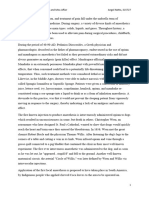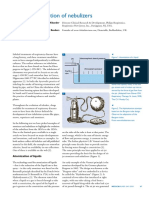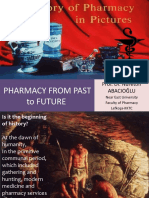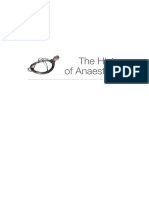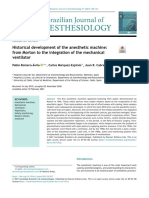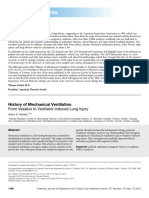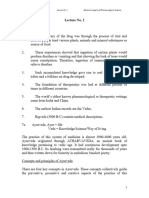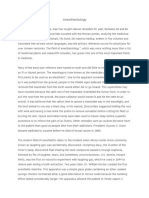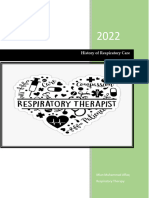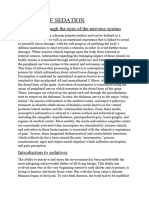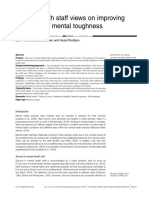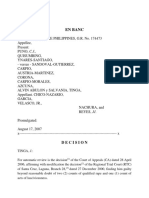Inhalation Therapy
Inhalation Therapy
Uploaded by
Sintha PratiwiCopyright:
Available Formats
Inhalation Therapy
Inhalation Therapy
Uploaded by
Sintha PratiwiCopyright
Available Formats
Share this document
Did you find this document useful?
Is this content inappropriate?
Copyright:
Available Formats
Inhalation Therapy
Inhalation Therapy
Uploaded by
Sintha PratiwiCopyright:
Available Formats
Copyright: General Practice Airways Group 2007
Primary Care Respiratory Journal (2007) 16(2): 71-81
PRIMARY CARE
RESPIRATORY
JOURNAL
REVIEW
http://www.thepcrj.org
Inhalation therapy: an historical review
Mark Sanders
a
b
a,b,*
Pharmaxis Ltd
Creator of inhalatorium.com.
Received 6th November 2006; accepted 11th November 2006
KEYWORDS
Inhalation therapy;
History;
Asthma;
Devices
Summary: Inhalation has been employed as a method for delivering medications
for more than two thousand years, and the benefits of delivering medication directly
to the affected site the lungs have been understood for more than two hundred
years. At the beginning of the Industrial Revolution, physicians were inventing
therapies and experimenting with ideas for devices: it was a time of great creativity.
However, by the end of the period the scientist and the regulated pharmaceutical
industry had emerged and the role of the physician had been constrained. Few of the
devices invented then remain in use today, but many of the principles used are still
embodied in modern devices. This review traces the developments produced by the
early pioneers who applied their creative thoughts to inhalation therapy, and
examines how inhaled drug delivery has progressed. The devices pictured are from
www.inhalatorium.com, an online museum of inhalation technologies.
2007 General Practice Airways Group. All rights reserved.
up
o
r
G
ays
w
r
i
A
ce
i
t
c
a
r
d
e
lP
t
i
a
r
b
i
e
h
n
e
ro
P
G
t
n
h
o
i
g
t
i
uc
d
o
r
Copyr
p
Re
Contents
Introduction ................................................................................................................
The inhaler ...............................................................................................................
Inhalation therapy in ancient times ....................................................................................
Inhalation therapy: the 1800s ...........................................................................................
The treatment of consumption .....................................................................................
Inhalational anaesthesia .............................................................................................
The first pressurised inhaler ........................................................................................
The treatment of asthma ............................................................................................
The first dry powder inhaler ........................................................................................
The Nelson inhaler ....................................................................................................
The formal recognition of inhalation therapy ....................................................................
The first nebulisation devices .......................................................................................
The age of advertising and the entrepreneur .........................................................................
Notable inhalers and inhaled therapies from a hundred years ago ...........................................
The end of the entrepreneur and the age of the scientist .........................................................
Modern times ...............................................................................................................
Conclusion ..................................................................................................................
References ..................................................................................................................
* Correspondence: 15 Friars Walk, Dunstable, Bedfordshire, LU6 3JA, UK
Tel: +44 (0)7711 995614; fax: +44 (0)1582 699732
E-mail address: ms@bethere.co.uk
1471-4418 2007 General Practice Airways Group. All rights reserved
doi:10.3132/pcrj.2007.00017
http://www.thepcrj.org
72
72
72
73
73
74
74
74
75
75
75
76
76
78
79
80
80
81
Copyright: General Practice Airways Group 2007
72
M. Sanders
Introduction
It is tempting to think of inhalation therapy as a
modern approach to drug delivery, but this would
negate some thousands of years of history and
literally hundreds of ingenious devices and hopeful
medications. This historical review describes the
development of inhalation therapy throughout the
ages, from its first recorded use in Ancient
Egyptian times through to the numerous different
sorts of inhalation device available today.
The inhaler
The word inhaler was first used by the English
physician, John Mudge. In his 1778 book, A Radical
and Expeditious Cure for a recent Catarrhous
Cough,1 he discloses to us his invention of an
inhaler adapted from a pewter tankard and the use
of opium vapour to treat cough (Figure 1). The
engraving in his book is not, however, the first
illustration of an inhaler. That honour goes to
Christopher Bennet in 1654 in his book Theatri
Tabidorum,2 with an inhaler that bore more than a
passing resemblance to a modern Turbohaler (see
Figure 2). These physicians were not just doctors
but they were also inventors and pioneers there
was no regulated pharmaceutical industry to supply
patient needs. Indeed, Mudge had to provide his
readers with the address of a pewterer in Fleet
Street, London who could make the Mudge inhaler.
Inhalation therapy was rationalised by Philip
Stern as early as 1764 the only possible way of
applying medicines directly to the lung is through
the windpipe. He advocated his own recipe of
balsamic vapours in his book, Medical Advice to
the Consumptive and Asthmatic Peoples of
England,3 controversially aimed at the public
rather than his peers.
Inhalation therapy in ancient times
Long before Bennet, Stern and Mudge were
describing inhalers and advocating inhalation
therapy, inhalation was being practised in many
parts of the world. The inhalation of the vapour of
black henbane is recorded in the ancient Egyptian
Ebers papyrus (1,554 BC); Egyptian physicians
threw the weed onto hot bricks, causing the
alkaloid contents of the plant to vapourise so that
the breathless patient could inhale.
In South and Central America, around 2,000
years ago, native populations had discovered the
therapeutic and recreational use of tobacco and
up
o
r
G
ays
w
r
i
A
ce
i
t
c
a
r
d
e
lP
t
i
a
r
b
i
e
h
n
e
ro
P
G
t
n
h
o
i
g
t
i
uc
d
o
r
Copyr
p
Re
Figure 1 John Rudge's pewter tankard inhaler, 1778
Figure 2 Diagram of Christopher Bennet's inhaler, 1654
http://www.thepcrj.org
Copyright: General Practice Airways Group 2007
Inhalation therapy: an historical review
Figure 3 South American tobacco pipes c. 2000 yrs ago
similar plants. They fashioned pipes which were
often ornately crafted see Figure 3.
In China, opium inhalation has a long history, and
ornate metal inhalers and incense burners are
associated with its practice. Accounts of asthma
predate the earliest accounts of inhalation
treatment, with the oldest accounts of asthma going
back to the time of the Yellow Emperor of China in
2,600 BC. Huang-Ti, author of the oldest known
book on internal medicine, identified the use of Ma
Huang, much later shown to contain ephedrine.
Inhalation therapy was also practised in other
ancient civilisations: in India, the practice of
inhaling the fumes of stramonium and hemp was
common, and in Ancient Greece the physician
Hippocrates (460-377 BC) advocated the inhalation
of vapours of herbs and resins boiled with vinegar
and oil which were then drawn into the lungs
through a tube. Over a thousand years later, Rhazes
(c850 AD-c923 AD), a physician in Baghdad,
advocated the inhalation of the vapour of arsenic.
More recently, at the end of the 12th century,
Maimonides (1135-1204 AD), the Spanish-born
physician to the Arab King Saladin, wrote the first
book on asthma (A Treatise on Asthma) in 1190,
and
recommended
numerous
treatments
(including chicken soup and sexual abstention) for
the kings son who was asthmatic.4 Among those
treatments was the inhalation of vapour
generated from herbs thrown onto a fire.
73
use a common teapot and inhale through the
spout5 though the subsequent tea may have had
an oddly balsamic flavour! Perhaps this suggestion
was the original inspiration for the later Nelsons
inhaler which indeed resembles a teapot
In 1802 Gent publicised and advocated the
ancient Indian practice of inhaling the vapours
generated by burning the leaves of Datura
Stramonium, and the inhalation of various such
mixtures became very popular throughout the
1800s. Stramonium produces the anticholinergic
agent atropine.
The celebrated physician Thomas Beddoes (17601808) founded the Pneumatic Institute at Clifton,
Bristol, for the treatment of disease by inhalation.
Beddoes work6 was the catalyst which fostered the
genius of his assistant, Humphrey Davy.
In 1811 Franois-Joseph Double, a notable
French physician, wrote Trait du Croup,7 a
dissertation on croup, stating, The inhalation of
vapour, medicated with ther, opium, or cicuta,
and pediluvia rendered a little irritating by the
addition of mustard, are also said to be
serviceable. It remains unclear by what means he
preferred the inhalations to be administered.
up
o
r
G
ays
w
r
i
A
ce
i
t
c
a
r
d
ofitconsumption
e
l P The treatment
a
r
b
i
e
h
n
e
ro
P
G
t
A key
driver for inhaler development during this
n
h
o
i
g
t
i
uc period was the treatment of consumption. Asthma
d
o
r
Copyr
p
was a relatively uncommon condition. All the
Re
Inhalation therapy: the 1800s
Twenty years after the appearance of Mudges
book,1 Cavallo pointed out that, rather than using
a purpose-made inhaler, the patient could simply
medications depended on heat to be volatilised or
vapour to be aerosolised.
Sir Charles Scudamore in his Cases illustrating
and confirming the remedial power of the
inhalation of iodine and conium in tubercular
phthisis and various disordered states of the lungs
and air-passages published in 1834,8 describes the
use of inhaling the vapour of hot water medicated
with iodine and conium (hemlock). The treatment
was given three times a day for 15-20 minutes each
time using water at 120F. He refers back to Galens
use of arsenic fumes or orpiment. Doctors Percival
and Withering are mentioned for their use of
inhaling carbonic acid gas generated by the reaction
of chalk and vinegar and Sir Alexander Crichton is
credited with the practice of inhaling the vapour of
boiling tar. Scudamore also refers to two French
doctors; M.Gannel for his use of chlorine inhalation,
and Laennec for his endeavours to create an artificial
marine atmosphere by use of seaweed (after having
observed improvement in patients taking sea
voyages). Scudamore advocated iodine and conium
after having experimented with inhalations of
stramonium, belladonna, lobelia, ipecacuanha,
digitalis, hydrocyanic acid and sulphuric ether.
http://www.thepcrj.org
Copyright: General Practice Airways Group 2007
74
M. Sanders
up
o
r
G
ays
w
r
i
A
ce
i
t
c
a
r
d the liquid medication
e
l P It used pressure
t
i
a
r
b
i
e
In 1834 Francis Ramadge developed
an
inhaler
to
atomise
h
n
e
ro
P
G
t
for treating consumption.
This was a long tubeion
see
Figure 4.
h
g
t
i
yther patient wouldpinhale
ucHe
througho
which
slowly.
p
d
o
r
C
e including tar, The treatment of asthma
records the inhalation ofR
vapours,
Figure 4 The first pressurised inhaler, 1858
Figure 5 Hyde Salter's account of burning nitre
papers, 1860
iodine, chlorine, hemlock, turpentine and others.
Inhalational anaesthesia
On October 16th 1846, the first demonstration of
inhaled anaesthesia took place. John Collins
Warren performed the operation and William
Morton delivered the anaesthetic. The surgeon
Henry Bigelow witnessed the operation and left an
excellent account and received much of the
credit. Within three weeks, on November 9,
Bigelow had written and presented his paper to
the Boston Society of Medical Improvement;10 an
abstract was presented at the American Academy
of Arts and Sciences on November 3. The following
month inhaled anaesthesia was being tried in
London. Anaesthesia demanded special inhalation
devices and there were numerous ones which
were rapidly developed.
The first pressurised inhaler
The first powered or pressurised inhaler was
invented in France by Sales-Girons and was
presented at the Medical Academy, Paris in 1858.11
In 1860, Henry Hyde Salter published his famous
text, On Asthma its Pathology and Treatment.12 He
systematically reviewed the treatment options of
the period, including inhaled therapies, and
distinguished between depressants (ipecacuanha,
tobacco, tartar-emetic), stimulants (coffee,
alcohol), and sedatives (tobacco, chloroform,
opium, Stramonium, Lobelia and Indian Hemp). The
inhalation of the fumes of burning nitre papers was
also discussed by Salter. Salter was unsure of the
origin of this practice, but estimates that it began
around 1860. He described its efficacy as being
beyond question and gave detailed accounts of four
treated cases see Figure 5. The activity of nitre
papers is attributable to ammonia which is formed
during the combustion process. However, vapours,
in general, did not form a significant part of his
armamentarium. Salter was very negative about
the value of opium in asthma, and regarded it as
being more a cause than a cure, although he did
accept its role in bronchitic cough.
In the USA in 1862, Charles Broadbent wrote A
Medical Treatise on the Causes and Curability of
Consumption, Laryngitis, Chronic Catarrh and
http://www.thepcrj.org
Copyright: General Practice Airways Group 2007
Inhalation therapy: an historical review
Diseases of the Air Passages Combining the
Treatment by Inhalation by Medicated Vapours.13
He eloquently makes the case for treatment by
vapour inhalation; The soothing and quieting
effects of these vapors is brought immediately to
act upon the parts locally irritated and diseased,
by the gentle inhalation of the vapor from a bottle
arranged expressly for the purpose He justifies
delivery of the drugs directly to the lungs; We
contend that no remedy, or combination of
remedies, however potent, whether allopathically
or homeopathically administered through the
medium of the stomach has ever nor can ever cure
a single case of asthma. For the reason that they
do not reach the seat of the disease, their
principal force is spent upon the general system,
and long before they find their way to the lungs,
their power is lost. His reasoning was very similar
to that of Stern and Mudge many years earlier.
Broadbent describes a rich list of inhalants
familiar to him, explaining that each was made to
the requirements of the individual patient;
Iodine, Conium, Oxygen, Hydrogen, Nitrogen,
Nitrous gas, a great variety of Gums and Balsamic
Resins, Vapor of boiling Tar, Hydrocyanic Acid,
Camphor, Ammonia, Balsam Tolu, Naphtha,
Chlorine, Hyoscyamus, Lactuca, Belladona,
Digitalic, Colchicum a great variety of Balsamic
Herbs, Galbanum, Vapor of Vinegar, Nitre,
Stramonium, Lobelia, Inflata, Ipecacuanha,
Alcohol, Hydriodate of Potassa, Storax,
Marshmallows, Rose Water, a great variety of
Emollient and Narcotic Herbs, &c. Broadbent was
clearly a remarkable experimenter in terms of the
range of substances that he employed to medicate
his vapours.
75
up
o
r
G
ays
w
r
i
A
ce
i
t
c
a
r
d
e
lP
t
i
a
r
b
i
e
h
n
e
ro
P
G
t
n
h
o
i
g
t
i
uc
d
o
r
Copyr
p
manufactured to this day, with very few
Re
Figure 6 The Improved Nelson inhaler, 1865
modifications. A vast number, many of them quite
ornate, have been produced under different
names and to different designs. Maws catalogue16
of 1869 shows two ceramic inhalers together with
Mudge inhalers, a Ramadge inhaler and others.
The first dry powder inhaler
The formal recognition of inhalation therapy
In London in 1864, Newton patented an inhaling
apparatus for the delivery of dry powder
medications.14 He observed that the powder
needed to be finely pulverised and that it had to
be kept dry principles that still apply to dry
powder inhalers today. His use of potassium
chlorate as a therapy was probably unfortunate
because this is now considered to be a lung
irritant. However, this device is probably the
earliest recorded dry powder inhaler.
The 1867 edition of the British Pharmacopoeia17
was the first to formularise inhalation therapies. It
listed five medications;
The Nelson inhaler
In 1865, a new invention was reported in The
Lancet15 the Improved Nelson Inhaler from the
well-known pharmacy supplier S.Maw & Sons in
London (see Figure 6). The Nelson inhaler is still
a) vapor
b) vapor
c) vapor
d) vapor
e) vapor
acidi hydrocyanici
chlori
coniae
creasoti
iodi
For any medical therapy, listing within a major
pharmacopoeia marks the medical acceptance of
that therapy. In this sense, inhalation therapy had
won its spurs and had been formally accepted as a
means of medical treatment. Nevertheless, most
of the substances listed above would now be
considered unsuitable for inhalation.
http://www.thepcrj.org
Copyright: General Practice Airways Group 2007
76
M. Sanders
In 1867, Armand Trousseau, one of Frances most
famous doctors, published a series of lectures
which were given in Paris.18 He reviewed asthma in
detail, referring to the inhalation of stramonium,
tobacco, hyoscyamus and belladonna. He also cited
the use of opium, arsenical cigarettes, nitre
papers, and described how to prepare these
products. Trousseau refers to Dr Faures method of
inhaling ammonia vapour for 15 minutes (four times
a day) from a vase at a distance of about one foot,
the nostrils needing to be occluded to avoid
unpleasant effects. He observed that some patients
respond better to one medication while others
respond better to another.
In 1869 the German doctor Louis Waldenburg,
writing about tuberculosis,19 claims to have
completely cured asthma through the continued
use of inhalations. He employed the use of sodium
chloride inhalations to soften the viscid mucus,
and oil of turpentine to stimulate the mucus
glands. Waldenburg also devised an apparatus for
delivering medicinal gases which he used
alongside the other inhalations.
Figure 7 Siegle's steam spray inhaler, early 1860's
also marketed. The ball contained a mixture of
glycyrrhiza and white hellebore (Veratrum vide)
together with a tarry residue smelling of carbolic
acid. The device cost ten shillings and was
refillable for five shillings see Figure 8.
The Carbolic Smoke Ball occupies an important
place in history, not only in terms of the evolution
of dry powder inhalers but also in law. It was
advertised as being a positive cure for a range of
respiratory conditions including influenza, asthma,
bronchitis, croup, whooping cough and many
others. Testimonials from many notable people
were also published. The advertisement offered a
100 reward to anyone who contracted influenza
having used the Carbolic Smoke Ball according to
the directions. Mrs Calill, despite using her Carbolic
Smoke Ball in accordance with the directions,
contracted influenza. Her claim for 100
compensation was ignored by the manufacturer and
so her husband, a solicitor, sued. When the case
came to trial in 1892, the defence vigorously argued
that the advertisement did not constitute a binding
obligation, but the judge found for Mrs Calill, a
decision that was supported in the Court of Appeal.
This established the legal principle that offers made
through advertising constitute a legal contract, and
consequently the Carbolic Smoke Ball Company
modified its advertising, focussing instead on the
testimonials of famous users. Mrs Calill lived to the
age of 96, eventually dying of influenza in 1942
During the 1880s through to the early 1900s
there was a proliferation of inhalers and inhalants
produced both in the USA and in Europe. The age of
the quack cure had truly begun and the
entrepreneurial spirit was applied to curing asthma.
New plastic materials such as Gutta Percha and
Bakelite became available. Distribution systems for
supplying drugs further afield improved and
advertising of medicines became commonplace. All
these aspects contributed to feed the expanding
demand for such cures. Inhalers were not the only
up
o
r
G
ays
w
The first nebulisation devices
r
i
A
e
c
i
t
c
a
r
d
Da Costa published a fine account of inhalation
P
e
l the
t
i
a
r
b
i
e
h
medications and devices in 1867.
Among
n
e spray and theion Pro
G
t
devices described are
the
hand-ball
h
g
t
i
r
c
y
u
Siegleso
steam
spray
inhaler a German
invention
p
d
o
r
C
p 7). Siegles
eFigure
from the early 1860s (see
R
steam spray used the Venturi principle to atomise
20
liquid medication, and this was, in effect, the
beginning of nebuliser therapy.
Writing in 1878, Berkart identified the use of
turpentine and assafoetida as a mucolytic,21 and
commented how they were best administered as
inhalations. He also describes a spray-producing
apparatus about which he expressed some
disappointment, which he rationalised as being
due to the spray not always helping the deeper
structures of the lung. The importance of droplet
size is now much more thoroughly understood and
controlled in modern nebulisers.
The age of advertising and the
entrepreneur
Frederick Roe patented the Carbolic Smoke Ball in
1889 as a device to facilitate the distribution,
inhalation, and application of medicated
powders.22 The patent describes a hollow rubber
ball with a sieve across the orifice to deagglomerate the powder inside. When squeezed, a
cloud of powder was produced. A glass version was
http://www.thepcrj.org
Copyright: General Practice Airways Group 2007
Inhalation therapy: an historical review
up
o
r
G
ays
w
r
i
A
ce
i
t
c
a
r
d
e
lP
t
i
a
r
b
i
e
h
n
e
ro
P
G
t
n
h
o
i
g
t
i
uc
d
o
r
Copyr
p
Re
Figure 8 An advertisement for the Carbolic Smoke Ball, 1889
Figure 9 Collage of adverts of various inhalers from around 100 years ago
http://www.thepcrj.org
77
Copyright: General Practice Airways Group 2007
78
M. Sanders
advertised cures for asthma though magnetism,
ultra-violet rays and numerous pills, creams and
potions were also promoted.
Notable inhalers and inhaled therapies from
a hundred years ago
Antiseptic inhalation. Following Listers hugely
important discovery of antiseptic surgery the
notion of inhaled antiseptics was promulgated.
Coal tar derivatives such as Vapocresolene were
promoted. Booths Hyomei was another heavily
promoted medication that provided dry air from
a small bakelite inhaler. The Cigar Inhaler was a
clever discreet design for discreet inhalation of
the antiseptic substance Gomenol. Dr Worsts
inhaler, a beautifully crafted nickel plated device
was patented in 1901. Compound Oxygen was
another heavily promoted cure that relied heavily
on testimonial advertising. A collage of adverts is
shown in Figure 9.
Ceramic inhalers. Numerous versions of the
Nelson inhaler and other ceramic inhalers
appeared to deliver medicinal products. In Europe
the enamel inhalers fulfilled a similar purpose.
Pillow inhaler. This clever approach involved the
use of a small shallow pot in a specially made
pillow. Volatile inhalants were put into the pot and
these were vapourised through the night, delivering
medication to the sleeping patient see Figure 10.
Combustible powders. These were to be burnt
and the arising vapour inhaled. Most contained
stramonium plus other alkaloids such as
belladonna and lobelia. Well known examples
include Braters Powder, Kinsman Powder, Green
Mountain Powder, Kelloggs Powder, Schiffmanns
Powder, and Himrods see Figure 11. Many were
also produced as asthma cigarettes (see Figure 12)
and as a pipe mixture.
Menthol inhalers. Menthol and eucalyptus oil
are well known today as over-the-counter
therapies for cough and cold relief. Since Gaubius
in 1774 first extracted crystals from peppermint
oil, later to be known as menthol, inventors have
been finding ways of delivering its cooling vapours
to the respiratory tract.
Oxygen bars. These were first developed in the
1890s and were reported in Scientific American
(Supplement 999 Feb 23 1895). Just like today,
customers would inhale purified oxygen at a bar. In
France, an establishment was set up in 1891 by
Doctors Labb, Oudin & Desnos for treating patients
with anaemia and tuberculosis; it was located in
Saint Raphael, France, beneath a casino. Ozone was
generated on the premises by ozonizers and was
available in two concentrations see Figure 13.
Figure 10 The pillow inhaler
up
o
r
G
ays
w
r
i
A
ce
i
t
c
a
r
d
e
lP
t
i
a
r
b
i
e
h
n
e
ro
P
G
t
n
h
o
i
g
t
i
uc
d
o
r
Copyr
p
Re
Figure 11 Various powders used in combustible inhalers
Figure 12 Asthma cigarettes
Figure 13 Depiction of an Oxygen Bar, 1890's
http://www.thepcrj.org
Copyright: General Practice Airways Group 2007
Inhalation therapy: an historical review
79
Figure 15 The Abbott Aerohaler, 1948
Figure 14 The Maxim inhaler, 1909
successful use of nebulised adrenalin in an oxygen
stream. Adrenalin Chloride (epinephrine) solution
1:100 was supplied in the 1930s as a bronchial
muscle relaxant, to reverse constriction; it was
vapourised through electrical compressors such as
the Pneumostat or by hand nebulisers such as the
Parke-Davis Glaseptic. Adrenalin was a life-saving
drug but had significant associated problems.
The use of atropine for the treatment of asthma
was also being explored at this time. Von Terray
claimed that atropine given hypodermically was a
specific treatment for asthma. Weiss found good
results from spraying it through the mouth.
Throughout the early 20th century there were
some notable inhaler inventions:
In the 1920s, the first mention of the inhalation
of atropine from an atomizer was made by Hurst.
In 1924, Schmid and Chen, whilst investigating
Ma Huang, identified ephedrine24 a substance
similar to adrenaline. This alkaloid was
subsequently used by inhalation.
In the 1930s, early compressor nebulisers (such
as the Pneumstat) were used to deliver adrenal
extracts and papaverin (Bronchovydrin).
In 1940, isoprenaline was first described by
Konzett, and it rapidly became available for
inhalation.
In 1948, Abbott launched the Aerohalor with a
preparation of penicillin for inhalation.
Additionally a further presentation of the
bronchodilator Norethisderone was also made
available. The Abbott Aerohalor, a dry powder
inhaler, used a lactose-based formulation to
deliver penicillin from small capsules known as
sifters see Figure 15.
In 1950, Reeder and Mackay treated pneumonia
with inhaled corticosteroid, leading to intensive
investigation into the use of inhaled antiinflammatories. Gelfrand, in 1951, reported on
five patients who were treated with nebulised
up
o
r
G
ays
w
r
i
A
ce
i
t
c
a
r
d
e
lP
t
i
a
r
b
i
e
h
n
e
ro
P
G
t
n
h
o
i
g
t
i
uc
d
o
r
Copyr
p
Re
Maxim inhaler. Sir Hiram Maxim, an American
living in London, was an inveterate inventor. Most
famous for the Maxim machine gun, he also
invented a steam driven flying machine! In August
1909, plagued by the effects of the London
atmosphere, he developed and patented his own
inhaler. It resembled a glass retort and delivered a
combination of menthol and pine essence (dirigo),
and was known as the Pipe of Peace. The pack
included a separate bulbous glass inhaler for nasal
delivery of menthol see Figure 14.
The end of the entrepreneur and the
age of the scientist
Controls on advertising and promotion imposed by
the FDA in 1906 sounded a death knell for the
entrepreneurial quack cures, and the scientist
took over. The general trend was that nationally
produced and licensed products superseded
locally produced devices.
In 1900 Solis-Cohen first used adrenal extracts
to treat asthma considered to be due to vasomotor
ataxia.23 The following year Bartlett advised the
use of 2 grains of dessicated adrenal extract three
times a day. In 1904, Kaplin and Bullowe identified
the value of adrenalin in asthma and it went on to
become the foundation of what we can consider to
be modern pharmaceutical inhalation therapy.
From 1910 onwards experiments into the delivery
of adrenalin began. Pick, in 1911, reported
successful nebulisation of adrenalin in two
patients. In 1929 Camps reported on the
http://www.thepcrj.org
Copyright: General Practice Airways Group 2007
80
M. Sanders
cortisone. In 1955, Foulds used hydrocortisone
in powder form. This work was ultimately to
lead to the discovery of beclomethasone nearly
20 years later.
Modern times
Undoubtedly the most significant event of the
1950s was the development in 1955 of the
pressurised metered dose inhaler (pMDI).25 Charles
Thiel working at Riker (3M) was one of the key
workers in the team that developed cold-fill pMDIs
using special valves developed by Philip
Maschberg. The products were shown to be
effective in studies conducted by Dr Carr at the
Veterans Administration Hospital (Long Beach,
California) in June 1955 and new drug applications
(NDAs) filed in January 1956 were approved in
March the same year. Medihaler-iso (isoprenaline)
and Medihaler-epi (adrenalin) were launched in
late March 1956. Nowadays, pMDIs have become a
very important inhalation technology with annual
sales currently in excess of 400 million units. The
drugs, of course, have been updated and the
propellant technology improved through the use
of less environmentally-damaging HFAs. The use of
pMDIs has, however, been limited by several
drawbacks: the need to co-ordinate the inhalation
and the actuation can prove difficult for patients;
the inhalers have lacked dose-counters; and their
ability to deliver large doses of drug is limited.
Bengers Laboratories (subsequently acquired by
Fisons Pharmaceuticals) were engaged in testing
the anti-allergic properties of synthetic cromone
derivatives of khellin (an Egyptian plant) during
the early 1960s. Dr Roger Altounyan, the real-life
Roger of Swallows and Amazons fame, himself an
asthmatic, personally tested the compounds. A
former Spitfire pilot who was very familiar with
aerodynamics, he invented the Spinhaler, a
capsule inhaler that used a small propeller to
create turbulence. It was necessary to find
alternatives to the standard pMDI technology
because the dose to be delivered exceeded the
capability of pMDI metering valves. Intal (sodium
cromoglycate) was launched in 1967 as a Spinhaler
device. Some years later a pMDI version was
created, using a lower dose.
The following year, 1968, the remarkable
bronchodilator actions of salbutamol were
described by Lunts, working at Allen and Hanburys.
Having been first synthesised in 1966, it was
marketed in 1969 as Ventolin, and rapidly became
the most prescribed bronchodilator globally.
Salbutamol was the first of the selective
bronchodilators, relatively free from secondary
effects on other systems. Salbutamol was
formulated in a pMDI, as a dry powder inhaler in the
Rotahaler and the Diskhaler, and was also produced
as nebulised, tablet and syrup formulations.
The Rotahaler, a dry powder capsule inhaler,
simply required twisting for a loaded capsule to be
pulled apart and the powder to be inhaled through
a mesh. The Diskhaler represented an important
step forward because it did not require reloading
for every dose, so it was the first multi-unit dose
dry powder inhaler. This inhaler used a cartridge
with foiled sealed pre-measured doses that were
perforated at the time of use to permit the drug
to be inhaled.
In 1972 Allen & Hanburys marketed the first
inhaled steroid, beclomethasone, in the same
inhalers as salbutamol. Numerous steroids have
subsequently been developed, and some have led
to new inhaler developments.
The Allen & Hanburys technology was refined
and substantially improved in the Diskus (Accuhaler)
which has proved outstandingly popular and which
is used to administer bronchodilator and antiinflammatory drugs and also combinations of the two.
In 1987, Astra Zeneca launched a novel steroid,
budesonide, in a new multi-dose dry powder
inhaler that did not depend on each dose being
isolated; rather, the drug substance was kept in a
reservoir from which individual doses were taken
at administration. This device, the Turbuhaler, has
also proved very popular and in a similar way is
now used to administer bronchodilators, inhaled
steroid, and combinations of the two.
Subsequent development of dry powder inhalers
has followed the three themes described above:
capsule inhalers; the multiple-unit dose inhalers;
and the reservoir devices.
up
o
r
G
ays
w
r
i
A
ce
i
t
c
a
r
d
e
lP
t
i
a
r
b
i
e
h
n
e
ro
P
G
t
n
h
o
i
g
t
i
uc
d
o
r
Copyr
p
Re
Conclusion
There is a rich history of ingenuity and
inventiveness that has accompanied the
development of inhalation therapy throughout the
ages. Our understanding of the engineering,
pharmacological, and medical science involved has
improved vastly. At the same time we have now
lifted our sights higher, aiming to use inhalation
therapy to treat diseases that involve systems
other than the lungs. New inventions await.
Conflict of interest declaration
The author is employed by Pharmaxis Ltd, holds
http://www.thepcrj.org
Copyright: General Practice Airways Group 2007
Inhalation therapy: an historical review
shares in Innovata plc, and is the creator of
www.inhalatorium.com
References
1.
Mudge J. A radical and expeditious cure for a recent
catarrhous cough. London: Allen,1778:1-252.
2. Bennet C. Theatri tabidorum vestibulum: seu
exercitationes dianoeticae cum historiis et experimentis
demonstratives. London: Newcomb,1654:1-126.
3. Stern P. Medical advice to the consumptive and asthmatic
peoples of England. London: Almon,1767:1-38.
4. Muntner S. Treatise on asthma by Maimonides.
Philadelphia: Lippincott,1963:1-115.
5. Cavallo T. An essay on the medicinal properties of
factitious air. London: Dilly,1798:1-256.
6. Beddoes T. Considerations on the medicinal use of
factitious airs and on the manner of obtaining them.
Bristol: Bulgin & Rosser,1796.
7. Double M, Traite du Croup, Fothergill S The medical and
physical journal. London: Adlard,1814 Jul-Dec:50-56.
8. Scudamore C. Cases illustrating and confirming the
remedial power of the inhalation of iodine and conium in
tubercular phthisis and various disordered states of the
lungs and air passages. London: Longman,1834:1-227.
9. Ramadge F. Consumption curable: and the manner in
which nature as well as remedial art operates in effecting
a healing process in cases of consumption. New York:
Howe,1839:1-160.
10. Bigelow H. Insensibility during surgical operations produced
by inhalation. Boston Med Surg J 1846;35:309-17.
11. Sales-Girons J. tude mdicale sur les eaux minrales de
Pierrefonds-les-Bains : application des eaux sulfureuses
pulvrises au traitement des malades de poitrine. Paris:
Delahaye,1864:1-190.
81
12. Salter H. On Asthma: its pathology and treatment.
London: Churchill & Sons, 1867:1-457.
13. Broadbent C. A medical treatise on the causes and
curability of consumption, laryngitis, chronic catarrh, and
diseases of the air passages. Combining the treatment by
inhalation of medicated vapours. Boston: Damrell & Welch,
1862:1-225.
14. Newton A. Inhaling Apparatus. UK patent 1161 7th May
1864.
15. Dr Nelsons improved earthenware inhaler. The Lancet Feb
11 1863:152.
16. Maws & son 1869 catalogue. London:66.
17. British Pharmacopoeia. London, Spottiswoode & Co,
1867:1-434.
18. Trousseau A, Lectures on clinical medicine delivered at the
hotel-Dieu, Paris. Vol 1 London: Hardwicke,1867:1-712.
19. Waldenburg L. Die Inhalation der zerstubten Flssigkeiten,
sowie der Dmpfe und Gase in ihrer Wirkung auf die
Krankheiten. Lehrbuch der respiratorischen Therapie
Berlin: Reimer, 1864:1-567.
20. Da Costa J. Inhalations in the treatment of diseases of the
respiratory passages, particularly as effected by the use of
atomized fluids. Philadelphia: Lippincott,1867:1-86.
21. Berkart J. On Asthma: its pathology and treatment.
London: Churchill,1878:1-264.
22. Snell N. The Carbolic Smoke Ball. Int J Pharm Med 2001;
15:195-6.
23. Brewis R. Classic papers in asthma. Vol 1 London: Science
Press, 1990:1-208 & Vol 2 London: Science Press, 1991:
1-214.
24. Chen K, Schmid C. The action of ephidrine, the active
principle of the Chinese drug Ma Huang. Pharm Exp
Therap 1924; XXIV, 339.
25. Crompton G. A brief history of inhaled asthma therapy over
the last fifty years. Prim Care Resp J 2006;15(6):326-31.
doi:10.1016/j.pcrj.2006.09.002.
up
o
r
G
ays
w
r
i
A
ce
i
t
c
a
r
d
e
lP
t
i
a
r
b
i
e
h
n
e
ro
P
G
t
n
h
o
i
g
t
i
uc
d
o
r
Copyr
p
Re
Available online at http://www.thepcrj.org
http://www.thepcrj.org
You might also like
- Topic 6 IB TB Questions and AnswersDocument33 pagesTopic 6 IB TB Questions and Answersgeorgia92% (12)
- 00 History of Indonesian Medicine & GarutDocument34 pages00 History of Indonesian Medicine & Garutacep sopianNo ratings yet
- An Overview of The Rabbit Industry in The PhilippinesDocument3 pagesAn Overview of The Rabbit Industry in The Philippinesallan variasNo ratings yet
- General Practice Airways Group Reproduction Prohibited: Inhalation Therapy: An Historical ReviewDocument11 pagesGeneral Practice Airways Group Reproduction Prohibited: Inhalation Therapy: An Historical ReviewliadiafaridaNo ratings yet
- History of AerosolsDocument22 pagesHistory of Aerosolsm jaaaNo ratings yet
- Ancient Pharmaceutical Industry:: Origin and EvolutionDocument9 pagesAncient Pharmaceutical Industry:: Origin and Evolutionsunnypar_1404No ratings yet
- History of AnesthesiaDocument79 pagesHistory of AnesthesiaMohammad Mansour100% (1)
- 2005 The Inhalation of Drugs, Advantages and ProblemsDocument16 pages2005 The Inhalation of Drugs, Advantages and ProblemsJessica Alejandra Pizarro MoralesNo ratings yet
- Essay 101Document7 pagesEssay 101Angel NettoNo ratings yet
- CW Issue 22 Art2Document5 pagesCW Issue 22 Art2Artem 521No ratings yet
- History of PharmacyDocument33 pagesHistory of PharmacyCarlos José Lacava FernándezNo ratings yet
- Historyof PharmacyDocument32 pagesHistoryof PharmacyDeepakNo ratings yet
- History of PharmacyDocument33 pagesHistory of Pharmacymalokkhan183No ratings yet
- c2c0cd139fda07ba6be5a534a2c33894Document13 pagesc2c0cd139fda07ba6be5a534a2c33894Jenny GamesonNo ratings yet
- Historical Background and Development of Profession of PharmacyDocument11 pagesHistorical Background and Development of Profession of PharmacyManthan PatelNo ratings yet
- Anesthesia and Critical Care Ventilator Modes: Past, Present, and FutureDocument15 pagesAnesthesia and Critical Care Ventilator Modes: Past, Present, and FutureTeuku RianNo ratings yet
- Early Evolution of NebulizerDocument7 pagesEarly Evolution of NebulizerXubair WajidNo ratings yet
- Chinese MedicineDocument6 pagesChinese Medicinekelvin100% (1)
- hhEF66 HTM PDFDocument354 pageshhEF66 HTM PDFJuan Diego De La Cruz MiñanoNo ratings yet
- History of PharmacyDocument6 pagesHistory of PharmacyLyes BazaNo ratings yet
- A History of Veterinary AnaesthesiaDocument10 pagesA History of Veterinary AnaesthesiaDiana NiculaeNo ratings yet
- Homeopathy TreatiseDocument33 pagesHomeopathy TreatiseMegha Aggarwal50% (2)
- Pharmacy From Past To FutureDocument53 pagesPharmacy From Past To FutureNurettin AbacıoğluNo ratings yet
- The Evolution of Veterinary Anaesthesia: "Shell" R S Arch Limited, Tunstall Laboratory Sittingbourne KentDocument7 pagesThe Evolution of Veterinary Anaesthesia: "Shell" R S Arch Limited, Tunstall Laboratory Sittingbourne KentDiana NiculaeNo ratings yet
- History of Medicinal PlantsDocument15 pagesHistory of Medicinal PlantsjayaprinaNo ratings yet
- Types of Anesthesia: Anesthesia, or Anaesthesia (SeeDocument10 pagesTypes of Anesthesia: Anesthesia, or Anaesthesia (Seesaiga0805No ratings yet
- Miller 7th Ed Chapter I HistoryDocument35 pagesMiller 7th Ed Chapter I Historyjbahalkeh7570No ratings yet
- History of PharmacyDocument17 pagesHistory of Pharmacytwinklingsubi16No ratings yet
- SBT1302Document155 pagesSBT1302ballubhai0333No ratings yet
- History of AnaesthesiaDocument10 pagesHistory of AnaesthesiaJORGE ALBERTO FIERRO LEYVANo ratings yet
- E-Learning PHARM 131 - Chapter2Document10 pagesE-Learning PHARM 131 - Chapter2Ryan Charles Uminga GalizaNo ratings yet
- History of PharmacyDocument6 pagesHistory of PharmacyMaycee AngeloNo ratings yet
- Herbalism - A ReviewDocument10 pagesHerbalism - A Reviewxiuhtlaltzin100% (1)
- Kul Sejarah Farmasi UmyDocument43 pagesKul Sejarah Farmasi UmyFadhel MuhammadNo ratings yet
- A Short History of The Old Trip of SterilizationDocument21 pagesA Short History of The Old Trip of SterilizationsamuelNo ratings yet
- GK For Veterinary PDFDocument20 pagesGK For Veterinary PDFMohammed Adil0% (1)
- Pharmacopoeia - WikipediaDocument19 pagesPharmacopoeia - Wikipediapalausha2005No ratings yet
- A History of Veterinary Anaesthesia Nov011Document9 pagesA History of Veterinary Anaesthesia Nov011Lorena B-iNo ratings yet
- The Art of Cupping Therapy The Rise andDocument7 pagesThe Art of Cupping Therapy The Rise andVladislav StevanovicNo ratings yet
- Résumé Anglais PharmacieDocument14 pagesRésumé Anglais PharmacieMaya BoukhariNo ratings yet
- The Story of OzoneDocument58 pagesThe Story of OzoneTee R Taylor100% (1)
- 2 Tema History of MedicineDocument6 pages2 Tema History of MedicineUgnė TurauskaitėNo ratings yet
- A Brief History of SterilizationDocument12 pagesA Brief History of SterilizationismaelsalehNo ratings yet
- Ideas About DiseaseDocument2 pagesIdeas About Diseaseangelicacamilla2005No ratings yet
- Maquina Anestesia PDFDocument14 pagesMaquina Anestesia PDFLider GaleNo ratings yet
- 64 1 The Iron LungDocument27 pages64 1 The Iron LungSriArthiNo ratings yet
- Noninvasive VentilationDocument38 pagesNoninvasive VentilationPaoly PalmaNo ratings yet
- Ats 2022Document10 pagesAts 2022EN BUNo ratings yet
- Lecture No. 2 (Historical Aspects of Pharmacological Sciences)Document7 pagesLecture No. 2 (Historical Aspects of Pharmacological Sciences)tejasbhukal567No ratings yet
- AnesthesiologyDocument3 pagesAnesthesiologyonline.course556No ratings yet
- History of Pharmacy NewDocument34 pagesHistory of Pharmacy Newdhiaalhaq8563No ratings yet
- RT HistoryDocument2 pagesRT HistoryIhteshamNo ratings yet
- Traditional Medicine: From Wikipedia, The Free EncyclopediaDocument4 pagesTraditional Medicine: From Wikipedia, The Free EncyclopediaBethi VenkateshwarluNo ratings yet
- History DevelopmentDocument9 pagesHistory DevelopmentKavi rajput83% (6)
- Herbalism - Wikipedia, The Free EncyclopediaDocument22 pagesHerbalism - Wikipedia, The Free EncyclopediaJ-smile OtukoyaNo ratings yet
- The History of Hyperbaric Chamber - Cap1 PDFDocument6 pagesThe History of Hyperbaric Chamber - Cap1 PDFOlga Moreno BusquetsNo ratings yet
- Resurgence of HijamahDocument7 pagesResurgence of HijamahAzhar JabeenNo ratings yet
- Concise Textbook of Forensic Medicine Toxicology 3rd Edition Rk Sharma All Chapters Instant DownloadDocument60 pagesConcise Textbook of Forensic Medicine Toxicology 3rd Edition Rk Sharma All Chapters Instant Downloadwaluslewannu100% (4)
- Capítulo Historia de La MH Kewal K. Jain (Auth.)Document7 pagesCapítulo Historia de La MH Kewal K. Jain (Auth.)Carolina CortezNo ratings yet
- Biology Report RoughDocument11 pagesBiology Report RoughVidyuth ThyagarajanNo ratings yet
- Capítulo Historia de MH. Neuman-Thom. 2011Document21 pagesCapítulo Historia de MH. Neuman-Thom. 2011Carolina CortezNo ratings yet
- Comparison of Effectiveness of A Progressive Mobilization and Mozart Music Therapy On Non-Invasive Hemodynamic Status Changes in Patients With Head Injury in The Intensive Care UnitDocument10 pagesComparison of Effectiveness of A Progressive Mobilization and Mozart Music Therapy On Non-Invasive Hemodynamic Status Changes in Patients With Head Injury in The Intensive Care UnitSintha PratiwiNo ratings yet
- Valley TemplateDocument2 pagesValley TemplateSintha PratiwiNo ratings yet
- KR 20 Dan KR 21Document2 pagesKR 20 Dan KR 21Sintha PratiwiNo ratings yet
- Mental Health Staff Views On Improving Burnout and Mental ToughnessDocument12 pagesMental Health Staff Views On Improving Burnout and Mental ToughnessSintha PratiwiNo ratings yet
- Instructions For Using The Mental Health Knowledge Schedule (MAKS)Document2 pagesInstructions For Using The Mental Health Knowledge Schedule (MAKS)Sintha Pratiwi100% (1)
- Security Center System Requirements Guide 5.10: Document Last Updated: July 12, 2021Document34 pagesSecurity Center System Requirements Guide 5.10: Document Last Updated: July 12, 2021Luiz Henrique AraújoNo ratings yet
- Variance and Standard DeviationDocument15 pagesVariance and Standard DeviationSrikirupa V Muraly100% (3)
- JAVA 8 FeaturesDocument34 pagesJAVA 8 FeaturesGaurav PathakNo ratings yet
- Norman FrosterDocument30 pagesNorman FrosterAvantika DhimanNo ratings yet
- Questions On Real Options in Capital BudgetingDocument2 pagesQuestions On Real Options in Capital Budgetingjoelmanoj98No ratings yet
- RefornationDocument2 pagesRefornationNarendran SairamNo ratings yet
- Imperatori Et Al (2022) - The Relationship Between Childhood Trauma Pathological Dissociation - FinalDocument2 pagesImperatori Et Al (2022) - The Relationship Between Childhood Trauma Pathological Dissociation - FinalzuveriaNo ratings yet
- Business of Being A WriterDocument31 pagesBusiness of Being A WriterTanmay MunjalNo ratings yet
- DLL - Mapeh 6 - Q1 - W8Document5 pagesDLL - Mapeh 6 - Q1 - W8Dexter Jan Cobol LantacoNo ratings yet
- Control Instrumentation EngineeringDocument2 pagesControl Instrumentation EngineeringWoon Jun ShenNo ratings yet
- Perspective of Stem Students.... Practical ResearchDocument22 pagesPerspective of Stem Students.... Practical Researchchristian demcoNo ratings yet
- NL23 - MDE - Hong Kong Event - World Dental Forum 4Document12 pagesNL23 - MDE - Hong Kong Event - World Dental Forum 4Sukla SarmaNo ratings yet
- Quantitative Aptitude AssignmentDocument3 pagesQuantitative Aptitude AssignmentnikhilNo ratings yet
- RCCB Test FormDocument2 pagesRCCB Test FormMega Legacy ResourcesNo ratings yet
- Novel Review - EnglishDocument2 pagesNovel Review - English11 ScienceNo ratings yet
- 01 QPython How To StartDocument5 pages01 QPython How To StartJack Ahm PeaceNo ratings yet
- CH 1Document21 pagesCH 1Naina GargNo ratings yet
- An Analysis of Trends and Sales in The Video Game Industry: Business Analytics ProjectDocument10 pagesAn Analysis of Trends and Sales in The Video Game Industry: Business Analytics ProjectNavpreet HansNo ratings yet
- When People Rebel 1857 and AfterDocument14 pagesWhen People Rebel 1857 and AfterDipankar KumarNo ratings yet
- People vs. AbulonDocument26 pagesPeople vs. AbulonAnonymous zuyKmfJNo ratings yet
- Here Are 25 Ways You Can Control Your Anger: Count DownDocument3 pagesHere Are 25 Ways You Can Control Your Anger: Count DownKevin Espiritu100% (1)
- Boston Bank v. ManaloDocument3 pagesBoston Bank v. ManaloReginaNo ratings yet
- Prevalence of Alcohol Impaired Long Distance Commercial Drivers in Aba and UmuahiaDocument11 pagesPrevalence of Alcohol Impaired Long Distance Commercial Drivers in Aba and UmuahiaInternational Journal of Innovative Science and Research Technology100% (1)
- ITDS LessonPlans Steps 1-4-202303Document5 pagesITDS LessonPlans Steps 1-4-202303fabioNo ratings yet
- Model Question Grade 12Document23 pagesModel Question Grade 12shresthall058No ratings yet
- Entrep Mind Module 2Document7 pagesEntrep Mind Module 2Wynnie RondonNo ratings yet
- Research in Clinical Pragmatics: Louise Cummings EditorDocument657 pagesResearch in Clinical Pragmatics: Louise Cummings EditorFel CruzNo ratings yet
- Research TitleDocument25 pagesResearch TitleMonica MinaNo ratings yet








